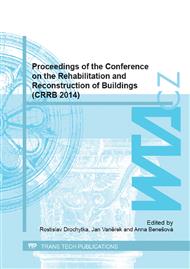p.157
p.161
p.165
p.169
p.173
p.177
p.181
p.185
p.191
Non-Destructive Defectoscopy of Building Structures by Lock-In Thermography
Abstract:
Nowadays there are many diagnostic methods for the detection of different defects in building structures. Destructive methods, which do not enable purposeful redevelopment action or a potential cause prediction of the defect without damage to the structure, are mostly used. Lock-in thermography is based on the modulation of the controlled heat flow, which impact on the diagnosed object. Heat (usually sinusoidal) wave penetrates inside the element and in the place of environmental change, ie. anomalies / deviations in the structure of the material of the tested object are reflected back to the surface. The paper focuses on the possibility of using lock-in thermography in the detection of various defects in building structures.
Info:
Periodical:
Pages:
173-176
Citation:
Online since:
August 2015
Authors:
Price:
Сopyright:
© 2015 Trans Tech Publications Ltd. All Rights Reserved
Share:
Citation:


